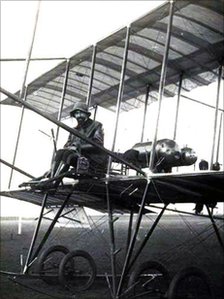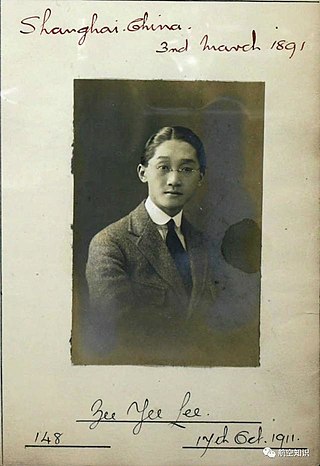
An aileron is a hinged flight control surface usually forming part of the trailing edge of each wing of a fixed-wing aircraft. Ailerons are used in pairs to control the aircraft in roll, which normally results in a change in flight path due to the tilting of the lift vector. Movement around this axis is called 'rolling' or 'banking'.

The history of aviation spans over two millennia, from the earliest innovations like kites and daring attempts at tower jumping to supersonic and hypersonic flight in powered, heavier-than-air jet aircraft. Kite flying in China, dating back several hundred years BC, is considered the earliest example of man-made flight. Leonardo da Vinci's 15th-century dream of flight found expression in several rational designs, though hindered by the limitations of contemporary science.
This is a list of aviation-related events from 1911:

This is a list of aviation-related events from 1912:
This is a list of aviation-related events from 1914.

The Etrich Taube, also known by the names of the various later manufacturers who built versions of the type, such as the Rumpler Taube, was a pre-World War I monoplane aircraft. It was the first military aeroplane to be mass-produced in Germany.

Military aviation comprises military aircraft and other flying machines for the purposes of conducting or enabling aerial warfare, including national airlift capacity to provide logistical supply to forces stationed in a war theater or along a front. Airpower includes the national means of conducting such warfare, including the intersection of transport and warcraft. Military aircraft include bombers, fighters, transports, trainer aircraft, and reconnaissance aircraft.
This is a list of aviation-related events during the 19th century :

Early flying machines include all forms of aircraft studied or constructed before the development of the modern aeroplane by 1910. The story of modern flight begins more than a century before the first successful manned aeroplane, and the earliest aircraft thousands of years before.

Ignaz "Igo" Etrich was an Austrian flight pioneer, pilot and fixed-wing aircraft developer.

The Austro-Hungarian Aviation Troops or Imperial and Royal Aviation Troops were the air force of the Austro-Hungarian Empire until the empire's demise in 1918; it saw combat on both the Eastern Front and Italian Front during World War I.

The Italian Corpo Aeronautico Militare was formed as part of the Regio Esercito on 7 January 1915, incorporating the Aviators Flights Battalion (airplanes), the Specialists Battalion (airships) and the Ballonists Battalion. Prior to World War I, Italy had pioneered military aviation in the Italo-Turkish War during 1911–1912. Its army also contained one of the world's foremost theorists about the future of military aviation, Giulio Douhet; Douhet also had a practical side, as he was largely responsible for the development of Italy's Caproni bombers starting in 1913. Italy also had the advantage of a delayed entry into World War I, not starting the fight until 24 May 1915, but took no advantage of it so far as aviation was concerned.

Edmund Elias Rumpler was an Austrian automobile and aircraft designer.

The Cody V was a single-engined biplane built by the British-based American aviation pioneer Samuel Franklin Cody in 1912. It was built from the remains of two of Cody's earlier aircraft, and won the 1912 British Military Aeroplane Competition, with two aircraft being purchased for the Royal Flying Corps. The design was abandoned after the mid-air disintegration of one of the aircraft in April 1913.

The Cody IV monoplane was a single-engined monoplane designed and built by the American-born but British-based aviation pioneer Samuel Franklin Cody in 1912. It was intended for entry into the 1912 British Military Aeroplane Competition, but was wrecked in a crash before the start of the competition.

Giulio Gavotti was an Italian lieutenant and pilot who fought in the Italo-Turkish War.

The Luft-Limousine or Luftlimousine, also known as Etrich VIII Luft-Limousine, was a single engine monoplane built by the Etrich company in Silesia in 1912.

Zee Yee Lee (Chinese: 厲汝燕; pinyin: Lì Rǔyàn; Wade–Giles: Li4 Ju3-yen4; 1891–1944) was a Chinese aviation pioneer. After becoming the first Chinese pilot to earn a Royal Aero Club certificate in October 1911, he brought two Etrich Taube monoplanes to China and flew on over Shanghai in April 1912. He was by some accounts China's first aviator, and was also one of the first Chinese aircraft designers. He served as the chief instructor and head of the Nanyuan Aviation School in Beijing for 15 years, and later taught at the predecessor of the Republic of China Air Force Academy.














